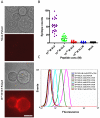Control of HIV-1 immune escape by CD8 T cells expressing enhanced T-cell receptor
- PMID: 18997777
- PMCID: PMC3008216
- DOI: 10.1038/nm.1779
Control of HIV-1 immune escape by CD8 T cells expressing enhanced T-cell receptor
Abstract
HIV's considerable capacity to vary its HLA-I-restricted peptide antigens allows it to escape from host cytotoxic T lymphocytes (CTLs). Nevertheless, therapeutics able to target HLA-I-associated antigens, with specificity for the spectrum of preferred CTL escape mutants, could prove effective. Here we use phage display to isolate and enhance a T-cell antigen receptor (TCR) originating from a CTL line derived from an infected person and specific for the immunodominant HLA-A(*)02-restricted, HIVgag-specific peptide SLYNTVATL (SL9). High-affinity (K(D) < 400 pM) TCRs were produced that bound with a half-life in excess of 2.5 h, retained specificity, targeted HIV-infected cells and recognized all common escape variants of this epitope. CD8 T cells transduced with this supraphysiologic TCR produced a greater range of soluble factors and more interleukin-2 than those transduced with natural SL9-specific TCR, and they effectively controlled wild-type and mutant strains of HIV at effector-to-target ratios that could be achieved by T-cell therapy.
Figures



References
-
- Goulder PJ, Watkins DI. HIV and SIV CTL escape: implications for vaccine design. Nat Rev Immunol. 2004;4:630–40. - PubMed
-
- Sewell AK, Price DA, Oxenius A, Kelleher AD, Phillips RE. Cytotoxic T lymphocyte responses to human immunodeficiency virus: control and escape. Stem Cells. 2000;18:230–44. - PubMed
-
- Phillips RE, et al. Human immunodeficiency virus genetic variation that can escape cytotoxic T cell recognition. Nature. 1991;354:453–9. - PubMed
-
- Price DA, et al. The influence of antigenic variation on cytotoxic T lymphocyte responses in HIV-1 infection. J Mol Med. 1998;76:699–708. - PubMed
-
- Cohen GB, et al. The selective downregulation of class I major histocompatibility complex proteins by HIV-1 protects HIV-infected cells from NK cells. Immunity. 1999;10:661–71. - PubMed
Publication types
MeSH terms
Substances
Grants and funding
LinkOut - more resources
Full Text Sources
Other Literature Sources
Research Materials

